The potentially hazardous asteroid 2024 ON looks like an adorable space peanut or a chunky snowman tumbling its way through the solar system in new close-up images of the ancient space rock.
The Deep Space Network’s Goldstone Solar System Radar near Barstow, California, captured a series of radar images of the near-Earth asteroid a day before its close approach to our planet. The close-up views of asteroid 2024 ON suggest it’s likely a contact binary, with two rounded lobes, one about double the size of the other, separated by a narrow neck, according to NASA.
2024 ON flew past Earth at an eerily close distance of 620,000 miles (1 million kilometers) on September 17. Through the radar images, NASA was able to determine a more accurate measurement of the asteroid, which stretches about 1150 feet (350 meters) long. The radar images also revealed bright spots, likely indicating the presence of large boulders on the surface of the asteroid.
Contact binaries are fairly common in the solar system; around 14% of near-Earth asteroids larger than 660 feet (200 meters) share the same awkward-looking peanut shape, according to NASA. It’s possible that these space rocks were once two asteroids that came too close to one another, becoming locked together in a gravitational dance and drawing nearer until they fused together as one body.
In November 2023, it was revealed that the asteroid Selam, a tiny moonlet orbiting around the larger Dinkinesh asteroid, is a contact binary after NASA’s Lucy spacecraft carried out its first close flyby of the odd trio. If a spacecraft isn’t available for a flyby, then radar imagery is the main technique astronomers use to reveal contact binaries.
Although it’s classified as a potentially hazardous asteroid, 2024 ON does not pose a threat to Earth in the foreseeable future. NASA dubs any space rock that comes within 4.65 million miles (7.5 million kilometers) of Earth as potentially hazardous, even if there is no immediate threat of it colliding with our planet.
Still, NASA needs to keep a close eye on these flying space rocks in case any slight adjustment to their trajectories puts them on a collision course towards Earth. The recent measurements obtained by the radar images “have allowed scientists to greatly reduce the uncertainties in the asteroid’s distance from Earth and in its future motion for many decades,” NASA wrote in a statement.
The last time 2024 ON made a close approach to Earth was in 2013, and it is scheduled for another rendezvous with our planet in 2035. Scientists wait for these flybys to make accurate measurements of space rocks, and to get a closer look at their sometimes awkward-looking shapes.
More: Beyond the Planets: The Quirky Underdogs of the Solar System

